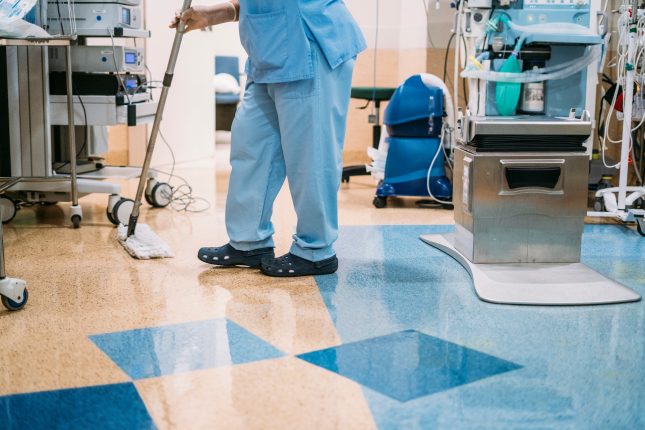
Infection control is a top priority for hospital staff. With patient lives on the line and budgets hanging in the balance, leadership is right to invest time, talent, and resources to minimize the risk of infection for every patient. Healthcare decision-makers are constantly seeking innovative solutions to enhance disinfection protocols and reduce healthcare-associated infections (HAIs) — while optimizing operational efficiency.
Common solutions to address HAIs include deploying disinfectants like bleach and hydrogen peroxide. However, the externalities, inefficiencies, and limitations of these harsh chemicals hinder their effectiveness. UV lights are another solution that many facilities turn to, but this time consuming, hands-on approach has many shortcomings and does nothing to accelerate turn times.
Meanwhile, hypochlorous acid (HOCl) offers a faster, more effective and non-toxic alternative. When paired with automated fogging technologies, it can reduce turn times while enhancing disinfection efficacy. Here’s how.
#1 Hands-Free Disinfection Keeps EVS Teams Active
Room cleaning and disinfection regimens can be both time and talent-intensive. One analysis found that the average room turnover time is over 38 minutes. This doesn’t include cleaning or changing bed linens and personal items, which adds another ten minutes to room turn times.
Integrating a hands-free HOCl fogging solution accelerates this process, creating labor efficiencies and improving disinfection. This significantly reduces downtime, improves overall cleanliness, and ensures a safer environment for everyone.
For example, when EVS teams leverage Nevoa’s Nimbus, technicians can perform other tasks while the fogger runs its single 30-minute disinfection cycle. This allows EVS to work ahead to clean and disinfect other rooms, accelerating terminal cleaning processes and ensuring a more efficient and streamlined operation.
In contrast, UV requires line of sight to be effective, so UV units must be monitored, repositioned, and run for multiple cycles to achieve adequate coverage. It also takes longer to kill pathogens. For example, effectively killing C. diff requires up to 45 minutes of UV exposure — in each position.
This time-consuming, hands-on requirement limits the ability of EVS teams to multitask, creating longer room turnover times and decreased overall efficiency. Healthcare facilities switching from UV disinfection solutions can expect to save a minimum of 10-20 minutes per room, significantly improving turnover rates and unlocking EVS teams to be more efficient and effective with their time.
#2 Automated Disinfection Reduces Manual Cleaning Tasks
Manual cleaning regimens require EVS teams to clean and disinfect dozens of items and surface areas. When fogging with HOCl, EVS teams can automate some of this process, reducing the overall number of manual cleaning tasks performed in each room as teams can rely on HOCl alone to disinfect low-touch surfaces, such as walls, that are often overlooked by EVS teams.
Automated disinfection introduces new labor efficiencies while improving outcomes. For example, when an inpatient hospice facility integrated Nevoa’s Nimbus into its terminal cleaning and disinfection procedures, EVS staff gained nearly 37 minutes of labor efficiency while achieving 100 percent room surface disinfection.
Notably, while Nimbus does not replace manual cleaning, it should be considered, at minimum, to complete 23 of the identified 66 manual disinfection tasks, effectively automating 34 percent of manual disinfection tasks while improving overall efficacy.
A study published by The National Library of Medicine determined that fogging with HOCl alongside manual terminal cleaning significantly reduces manual labor times. Specifically, the tandem cleaning protocol resulted in a 64 percent improvement in manual labor efficiency, reducing the average manual cleaning time from 18.2 minutes to 6.5 minutes per room.
Simply put, fogging with HOCl can reduce the number of manual tasks that must be completed to speed up room turn time.
#3 Better Disinfection Reduces HAIs and Keeps Rooms Open
More than a million HAIs are reported across the US healthcare system every year, increasing the average patient length of stay by 9.7 days — at the cost of the healthcare facility. In addition to the enormous toll this takes on patient outcomes, HAIs clog treatment spaces, delaying room turn times and access. With ER wait times already in a “Crisis Situation,” delaying terminal cleaning regimens and turn times creates cascading consequences for patients and providers.
The National Library of Medicine reports, “Environmental surfaces contribute significantly to the transmission of pathogens in healthcare environments.” The patient repercussions are enormous. The analysis found, “At least eight studies have shown an average 120% increased risk of acquiring a bacterial healthcare-associated infection (HAI) if the room was previously occupied by a colonized or infected patient.”
The equation is simple: fewer HAIs mean faster turn times and more patients receiving access to treatment spaces, making it a win-win-win for patients, hospital administrators, and EVS teams. Fogging with HOCl is an important step toward achieving this critical outcome. As The National Library of Medicine concludes, “The use of whole-room atomized disinfection with terminal cleaning protocols lowered manual labor times, improved disinfection outcomes, and eliminated the transfer of bacterial pathogens in healthcare environments.”
This doesn’t just apply to patient rooms. Emergency and operating rooms that require thorough cleaning and disinfection can accelerate turn times by automating the disinfection process with fogging. For instance, Nevoa’s Stratus handheld fogger uses HOCl to kill 99.9999 percent of pathogens in just two minutes, including the most common causes of surgery site infections, providing a portable and flexible disinfection solution for various healthcare settings.
Bring HOCl Fogging to Your Facility with Nevoa
Fogging with HOCl offers healthcare facilities a versatile, practical, and time-saving solution to the critical work of infection prevention. Nevoa is here to help.
We are revolutionizing the healthcare industry by providing technology-based solutions that automate disinfection and cleaning practices. These solutions ultimately accelerate turn times, reduce the risk of HAIs, and save lives.
Contact us to learn more about how we can bring HOCl-based fogging solutions to your facility today.
